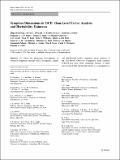Symptom Dimensions in OCD: Item-Level Factor Analysis and Heritability Estimates
Author(s)
Katerberg, Hilga; Delucchi, Kevin L.; Stewart, S. Evelyn; Lochner, Christine; Denys, Damiaan A. J. P.; Stack, Denise E.; Andresen, Joshua Michael; Grant, J. E.; Kim, Suck W.; Williams, Kyle A.; den Boer, Johan A.; van Balkom, Anton J. L. M.; Smit, Johannes H.; van Oppen, Patricia; Polman, Annemiek; Jenike, Michael A.; Stein, Dan J.; Mathews, Carol A.; Cath, Danielle C.; ... Show more Show less
DownloadAndresen_Symptom Dimensions.pdf (222.0Kb)
PUBLISHER_CC
Publisher with Creative Commons License
Creative Commons Attribution
Terms of use
Metadata
Show full item recordAbstract
To reduce the phenotypic heterogeneity of obsessive-compulsive disorder (OCD) for genetic, clinical and translational studies, numerous factor analyses of the Yale-Brown Obsessive Compulsive Scale checklist (YBOCS-CL) have been conducted. Results of these analyses have been inconsistent, likely as a consequence of small sample sizes and variable methodologies. Furthermore, data concerning the heritability of the factors are limited. Item and category-level factor analyses of YBOCS-CL items from 1224 OCD subjects were followed by heritability analyses in 52 OCD-affected multigenerational families. Item-level analyses indicated that a five factor model: (1) taboo, (2) contamination/cleaning, (3) doubts, (4) superstitions/rituals, and (5) symmetry/hoarding provided the best fit, followed by a one-factor solution. All 5 factors as well as the one-factor solution were found to be heritable. Bivariate analyses indicated that the taboo and doubts factor, and the contamination and symmetry/hoarding factor share genetic influences. Contamination and symmetry/hoarding show shared genetic variance with symptom severity. Nearly all factors showed shared environmental variance with each other and with symptom severity. These results support the utility of both OCD diagnosis and symptom dimensions in genetic research and clinical contexts. Both shared and unique genetic influences underlie susceptibility to OCD and its symptom dimensions.
Date issued
2010-04Department
Massachusetts Institute of Technology. Department of Chemical EngineeringJournal
Behavior Genetics
Publisher
Springer Science + Business Media B.V.
Citation
Katerberg, Hilga et al. “Symptom Dimensions in OCD: Item-Level Factor Analysis and Heritability Estimates.” Behavior Genetics 40 (2010): 505-517.
Version: Final published version
ISSN
0001-8244
1573-3297